Piazza della Signoria - Table of Contents .....................Architecture Around the World
Loggia
della Signoria
AKA: Loggia dei
Lanzi / Loggia dei Priori / Loggia dell'Orcagna
Piazza
della Signoria,
Florence, Italy
| Loggia pronunciation: |
LAW
jee a; LAHJ ee a |
| Signoria pronunciation: | English:
sig NOR ee a; Italian: SEEN nyor ee a |
| Built: |
1376 - 1382. |
| Architects: |
Simone di Francesco Talenti and Benci di Cione. |
| Original function: |
To
house the assemblies of the people, and hold
public ceremonies and the
official ceremonies of the Florentine Republic |
| Later function: |
One of the first open-air sculpture gallery spaces in the world. |
|
Loggia dei Lanzi
The Loggia dei Lanzi is a beautiful arched gallery that was built in the 14th century at the Piazza della Signoria right in front of the Palazzo Vecchio. This building is formally called the Loggia della Signoria, but is often referred to as the Loggia dei Lanzi due to German mercenary guards (in Italian: Lanzichenecchi, corrupted to Lanzi) who were stationed there on their way to Rome in the sixteenth century (1527). It was built in the fourteenth century by Simone di Francesco Talenti, Lorenzo di Filippo, and Benci di Cione. Construction occurred between 1376 and 1382. The beautifully proportioned open gallery was designed in a late Gothic style, a clear precursor to the soon to be popular Renaissance style. Michelangelo, one of the most prominent Renaissance artists, even proposed to extend the gallery along all sides of the Piazza della Signoria, but Cosimo I de’ Medici, Duke of Florence, eventually decided it would be too expensive. The loggia originally served to house the assemblies of the people, and hold public ceremonies and the official ceremonies of the Florentine Republic. The Lodge symbolized the Republic. The tradition of setting up statues in the loggia started in 1494 when the Florentines expelled the Medici, who had ruled over the city for more than 150 years. - Florence Inferno (online April 2020) |
 Loggia ... Left building: Uffizi Gallery ... Back wall: Six marble female figures, probably coming from the Trajan’s Forum in Rome, discovered in 1541 and brought to Florence in 1789 "With
its wide arches,
it opens to Piazza della Signoria,
adjoining the Uffizi Gallery [building at left in this photo],
and
features beautiful sculptures made by artist like Giambologna and
Benvenuto Cellini. Those arches seem to have influenced Brunelleschi
when he planned the first renaissance building: the Spedale
degli
Innocenti. After
the construction of the Uffizi, Buontalenti created a roof garden
above the arches of the Loggia, a terrace from which the Medici could
watch ceremonies in
the piazza. Today, you can reach this spectacular
terrace while visiting the Uffizi Museum. - VisitTuscany.com
(online April 2020)
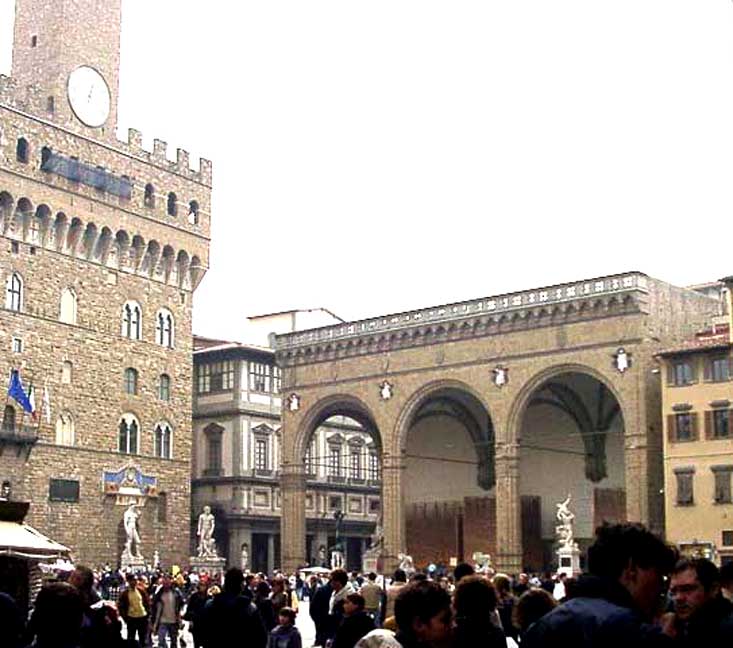 Left: Palazzo Vecchio 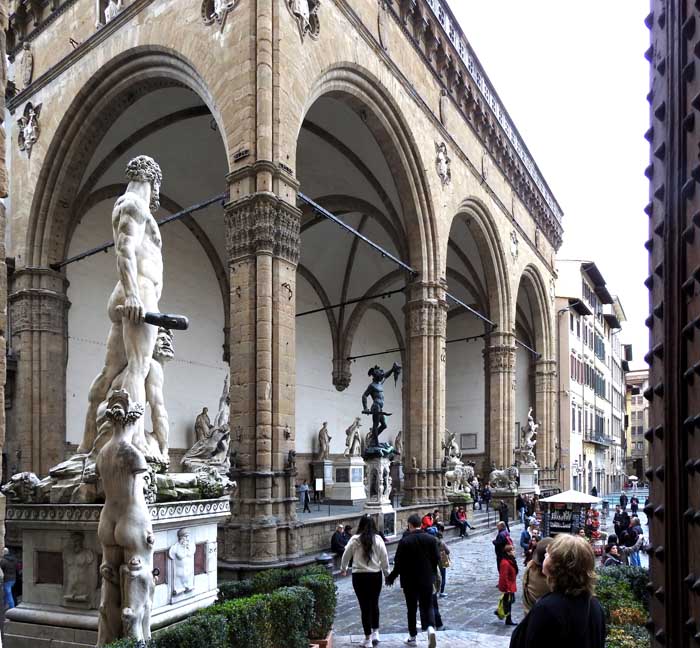 Photo taken from the steps of the Palazzo Vecchio 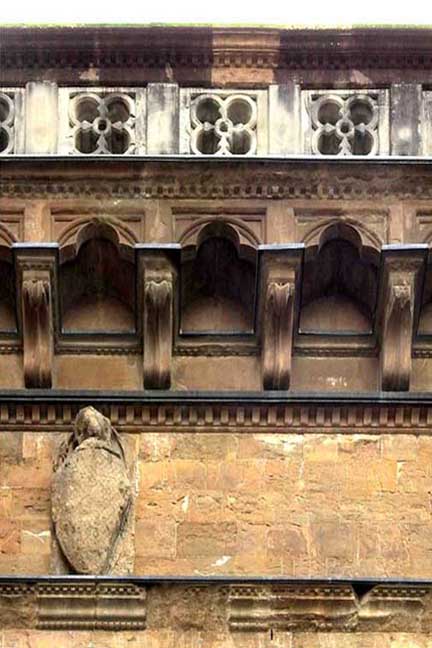 Quatrefoils decorate top parapet at the edge of the roof terrace ... Blind arcade ... Modillions ... Dentil molding ... Cartouche 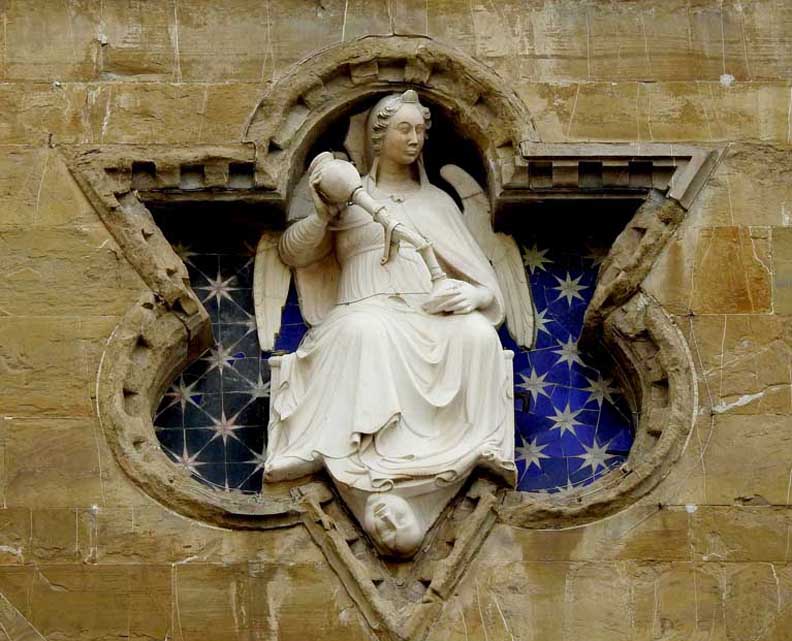 One of four allegorical figures of the four cardinal virtues (Fortitude, Temperance, Justice and Prudence) by Agnolo Gaddi (1383-1386)  Gothic groin vaults flank a rib ... Note sculpted corbel, detailed below: 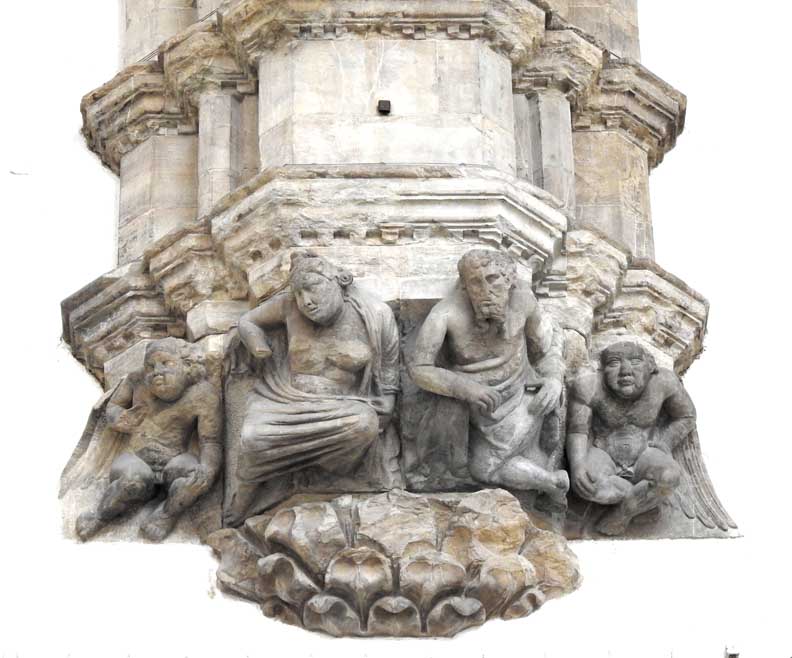 Corbel  Another back wall corbel 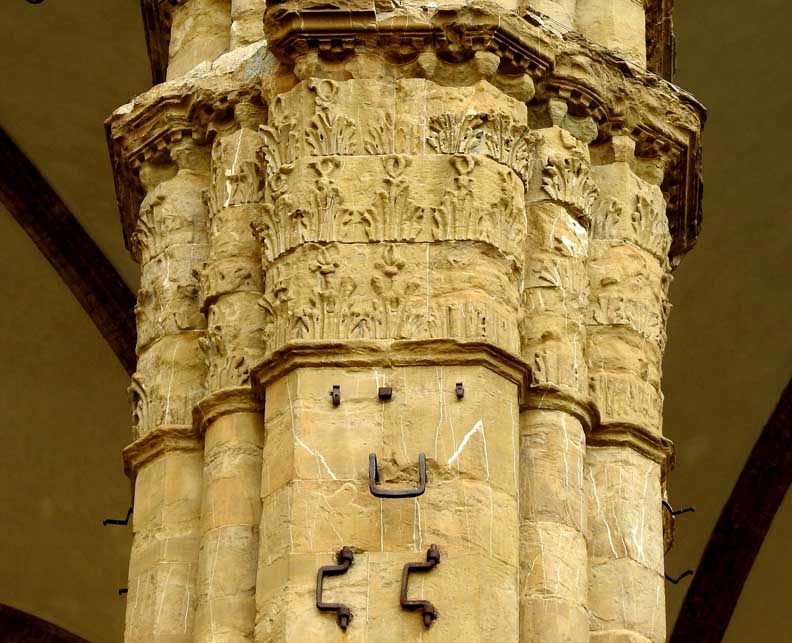 Capital decorated with acanthus leaves  Lion-head gargoyle, with feathered visitor |
Marzocco Lion 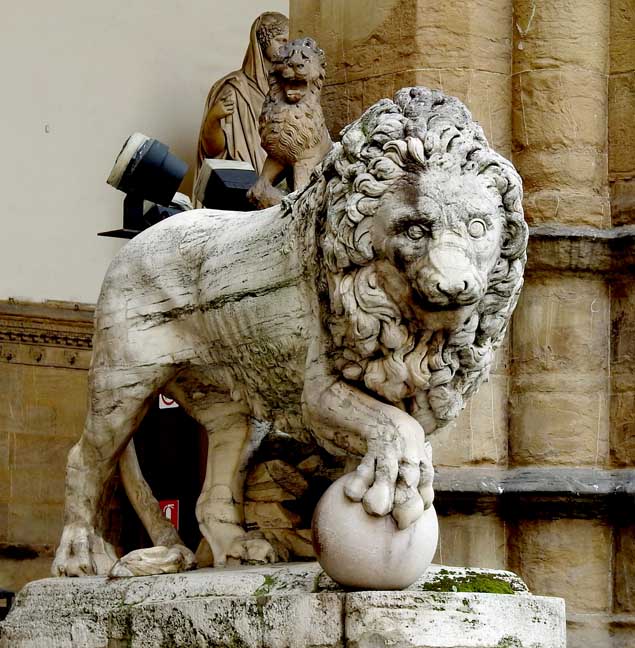 Marzocco Lion The heraldic lion that is a symbol of Florence, and was apparently the first piece of public secular sculpture commissioned by the Republic of Florence, in the late 14th century. ... One of two marble sculptures of lions, one from Roman times, the other sculpted by Flaminio Vacca in 1598 and was originally placed in the Villa Medici in Rome before being moved to the Loggia in 1789. 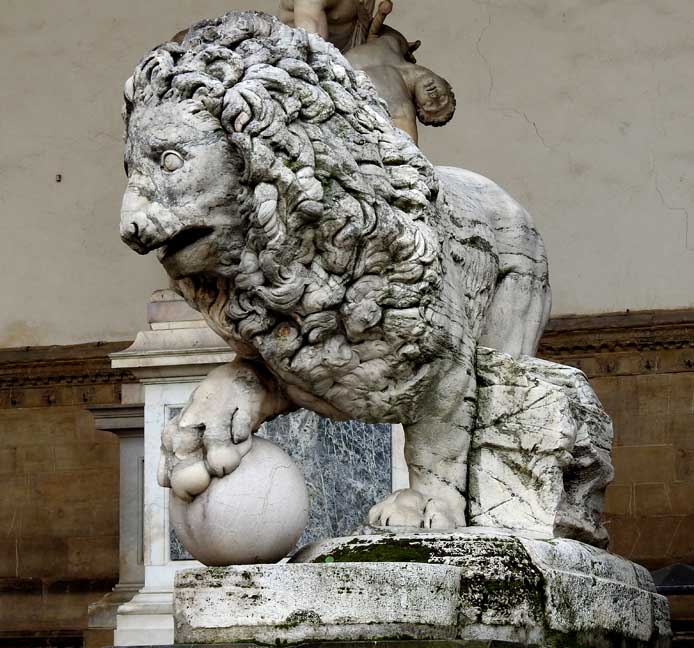 Marzocco Lion |
Perseus Holding the Severed Head of Medusa By Benvenuto Cellini  Perseus Holding the Severed Head of Medusa "The
tradition of setting up statues in the loggia started in 1494 when the
Florentines expelled the Medici, who had ruled over the city for more
than 150 years. The house of Medici soon regained its power in
Florence, and duke Cosimo I commissioned Benvenuto Cellini to
create a
sculpture depicting the mythical hero Perseus
after he beheaded Medusa. It took nine years
to be cast, and it shows the mythical Greek hero brandishing his sword
with his right hand and holding up the Medusa’s decapitated head with
his left hand, with blood gushing from the head and the neck.
"This bronze statue was supposed to represent the death of the republican institutions, through the swift cutting off of Medusa’s head, and the end of civil strife, as symbolized by the snakes. "Its
marble pedestal is a masterpiece in itself, largely due to the fine
workmanship of the small bronze figures representing the myth of
Perseus ." - Florence
Inferno (online April 2020)
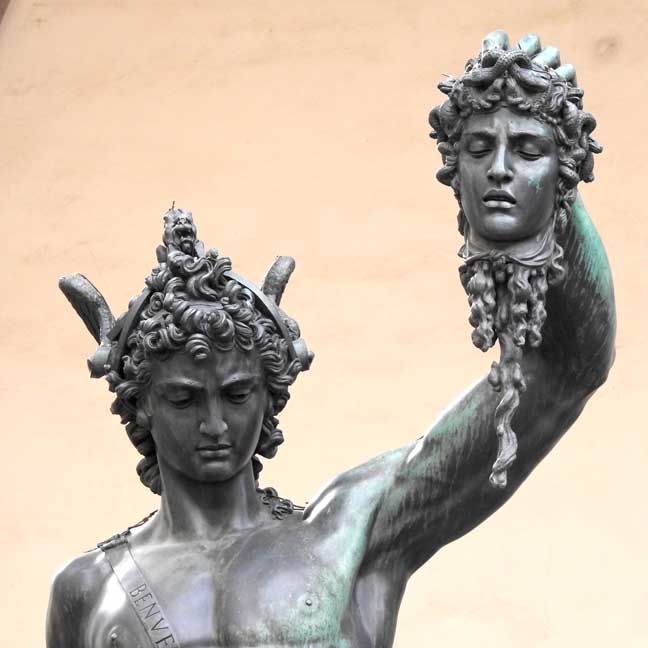 Perseus Holding the Severed Head of Medusa Note Medusa's snake hair 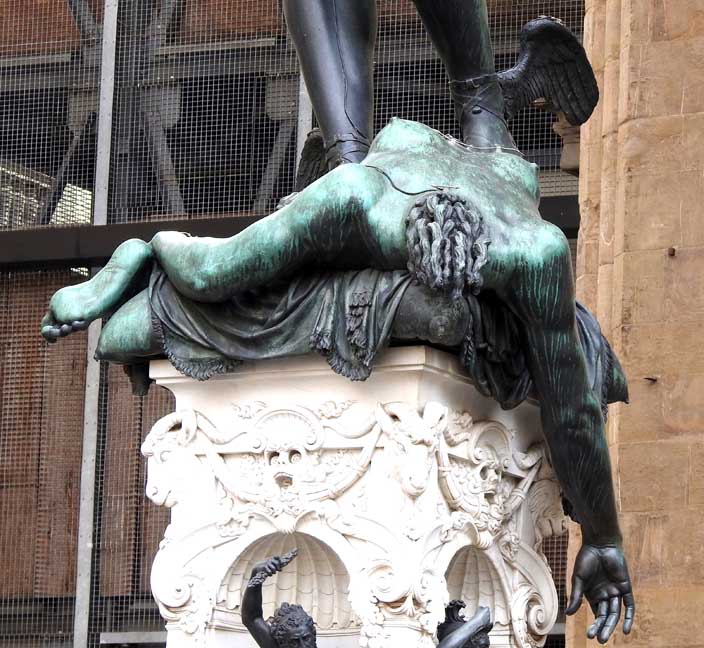 Perseus Holding the Severed Head of Medusa 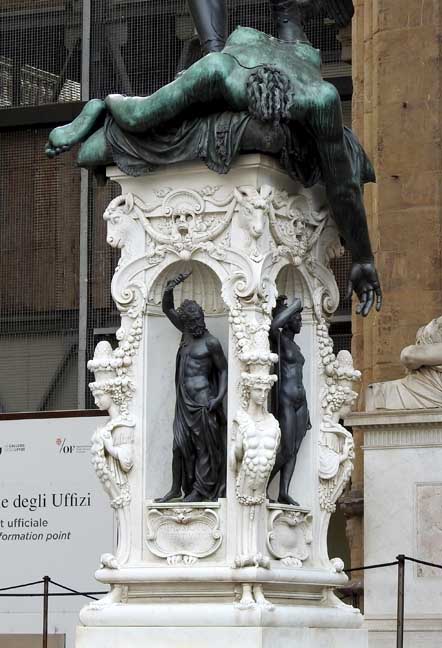 Perseus Holding the Severed Head of Medusa C-scrolls ... Three termini ... Cartouches |
| Rape
of the
Sabines / Abduction of a Sabine Woman By Giambologna (1579-1583) "This impressive marble group was installed here in 1583 at the behest of the son of Cosimo I, Francesco I. The statue is over 4 metres high and is the first group representing more than a single figure in European sculptural history to be conceived without a dominant viewpoint. It can be equally admired from all sides, and it was made from one imperfect block of white marble, the largest block ever transported to Florence." - Florence Inferno (online April 2020) "(As a note, the sculpture is also referred to as the Rape of a Sabine Woman, which can lead to confusion over the subject. In Latin, the word rapito means “abduction” (and in Italian, the verb rapire means “to abduct,” thus the title Abduction of a Sabine Woman is technically more correct than the Rape of a Sabine Woman, which has explicit connotations of sexual violence. And indeed, in Livy’s account of the episode, he claims there was not sexual violence, rather a variety of enticements by the Roman for how the women would be treated as their wives.)" - Smart History (online April 2020) 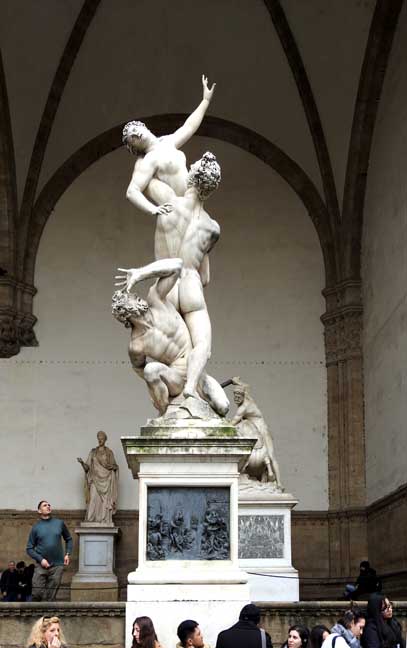 Rape of the Sabines / Abduction of a Sabine Woman Mannerist style "As
one enters the Academia
Gallery, one will find the plaster cast model by Giambologna (as
Jean
de Boulogne, 1579–1583, is known in Italy) displayed central-stage in
the Hall of the Colossus. From this model, Giambologna created the
marble sculpture you can admire in Piazza della Signoria under the
Loggia dei Lanzi.
"The cast depicts three figures connected by a serpentine-shaped movement, with one man lifting a woman into the air while a second man crouches. The name of “The Rape of the Sabines”, was suggested by his contemporary Vincenzo Borghini. What impacts the observer the most is the fact that the whole group was carved from a single block of marble, and is acknowledged as Giambologna’s masterpiece. "The three figures are constructed on a vortex that invites the observer to move around the statue and offers infinite view points. Inspired by Michelangelo and by mannerist ideals, Giambologna became famous for the search of intertwined figural compositions and over ambitious inclusive efforts. His ability to sculpt bodies in the old classical style and splendid figures of naked women in seductive poses increased his fame at the end of the XVI century." - Academia.org (online April 2020)  "The
subject is a dramatic
one from ancient Roman history. According to the accounts of both Livy
and Plutarch, after the city of Rome was founded in 750 B.C.E., the
male population of the city was in need of women to ensure both the
success of the city and the propagation of Roman lineage. After failed
negotiations with the neighboring town of Sabine for their women, the
Roman men devised a scheme to abduct the Sabine women (which they did
during a summer festival).
"What we see in Giambologna’s sculpture is the moment when a Roman successfully captures a Sabine woman as he marches over a Sabine male who crouches down in defeat. " - Smart History (online April 2020) 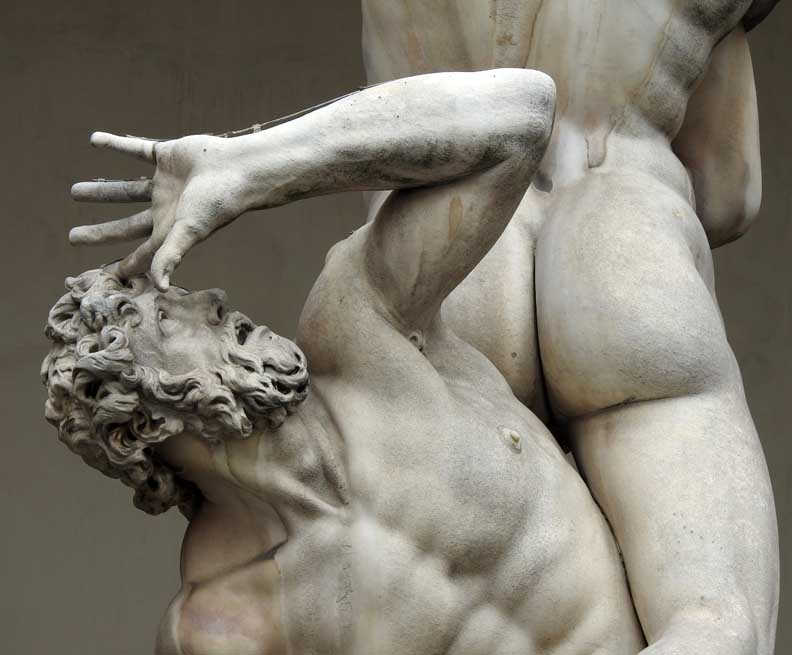 ""Giambologna’s works
exemplified the characteristics of the Mannerist
period, a time in
which artists exploited the idea of beauty for beauty’s sake in works
that showcased their artistic talent with figures composed of sinuous
lines, graceful curves, exaggerated poses, and a hyper-elegance and
preciousness that delighted viewers. These figures convey movement,
aggression, fear, and struggle, as they move upward in a flame-like or
twisting pattern known as figura serpentinata (serpentine figure),
popular with Mannerist artists of the period. - Smart
History (online April 2020)
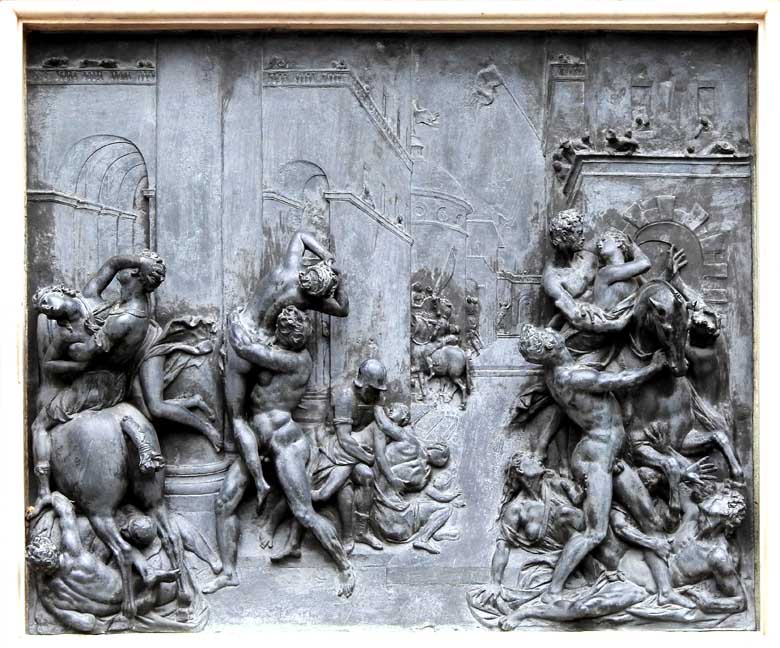 Mannerist style bas-relief, also by Giambologna See another sculpture by Giambologna in the illustrations below: |
| See another sculpture by Giambologna in the above illustration Hercules and the Centaur Nessus By Giambologna  Hercules and the Centaur Nessus A lesser-known sculpture of Giambologna, made in 1599, but placed where it is only in the nineteenth century  Hercules and the Centaur Nessus 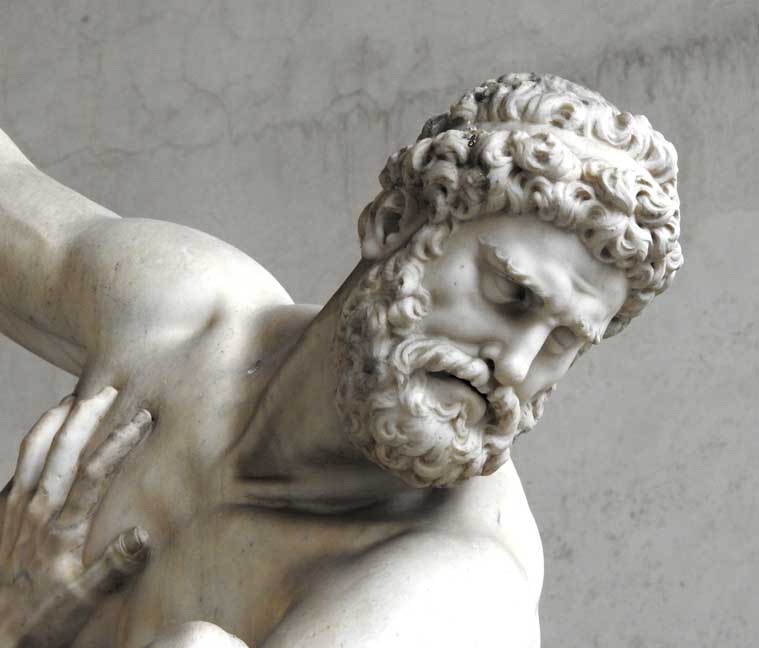 Hercules and the Centaur Nessus 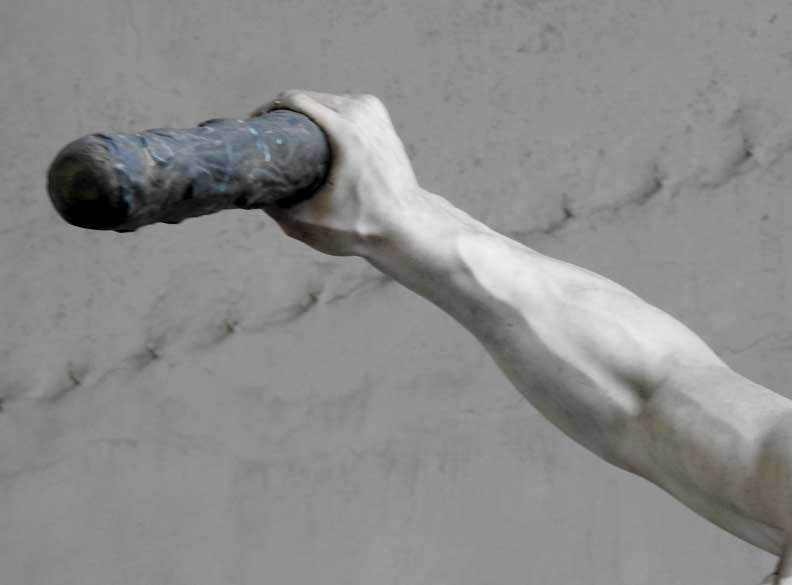 Hercules and the Centaur Nessus  Hercules and the Centaur Nessus |
Rape of Polyxena / Pyrrhus and Polyxena By Pio Fedi 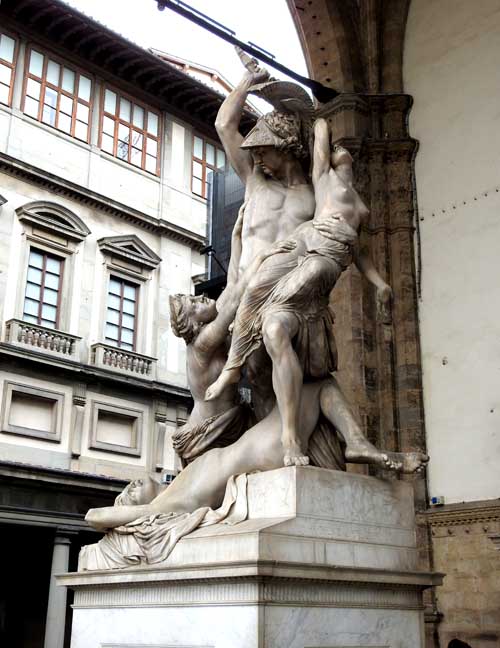 The Rape of Polyxena/Pyrrhus and Polyxena 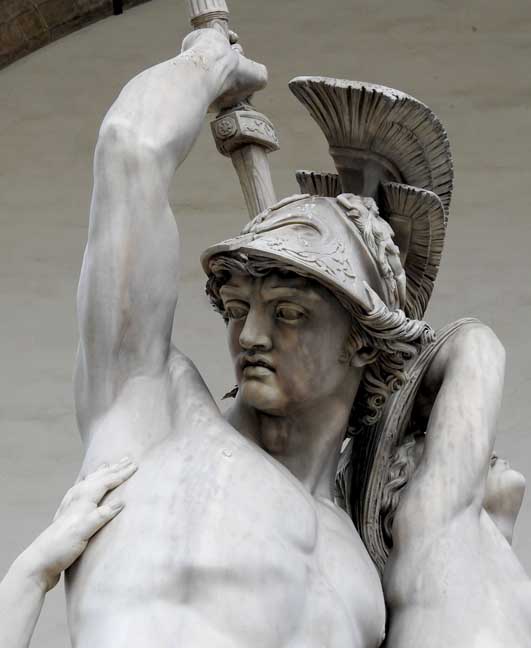 The Rape of Polyxena/Pyrrhus and Polyxena  The Rape of Polyxena/Pyrrhus and Polyxena |
Menelaus
and Patroclus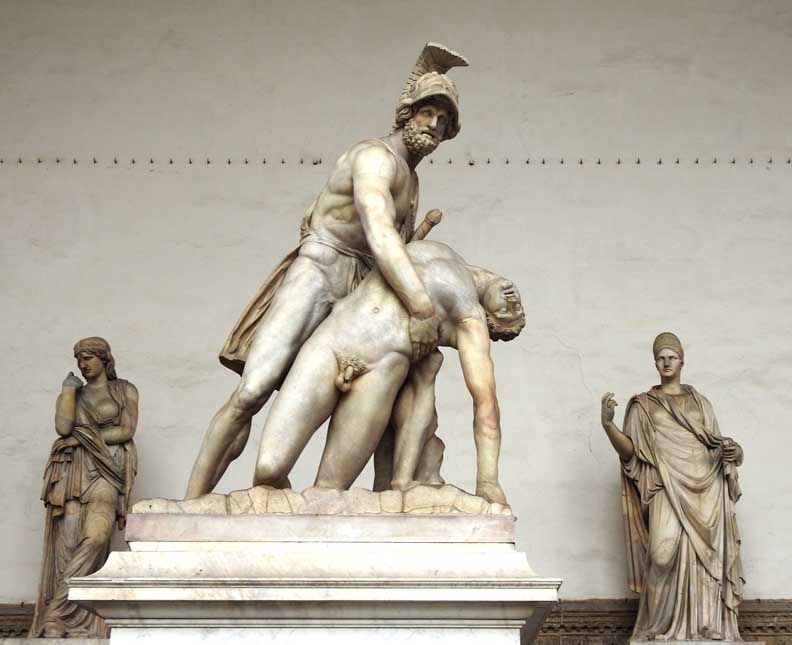 Menelaus supporting the body of Patroclus, a marble group of Roman times which originally stood at the end of the Ponte Vecchio ... Background: Two marble female figures, probably coming from the Trajan’s Foro in Rome, discovered in 1541 and brought to Florence in 1789 "The
group Menelaus supporting the body of Patroclus,
discovered in
Rome stood originally at the southern end of the Ponte Vecchio. There
is another version of this much-restored Roman marble in the Palazzo
Pitti.
"It is an ancient Roman sculpture from the Flavian era, copied from a Hellenistic Pergamene original of the mid third century BC. This marble group was discovered in Rome. It has undergone restorations by Ludovico Salvetti, to a model by Pietro Tacca (1640) and by Stefano Ricci (about 1830)."- Florence Inferno (online April 2020)  Menelaus and Patroclus 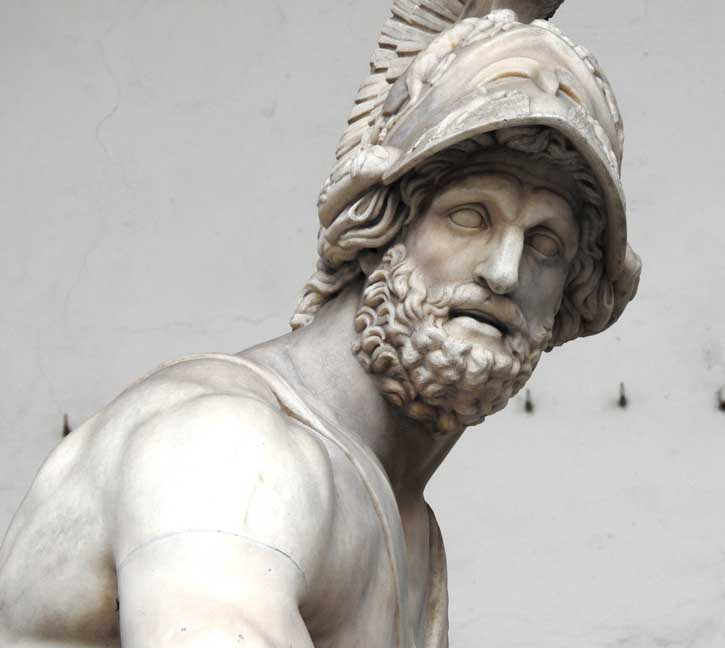 Menelaus and Patroclus 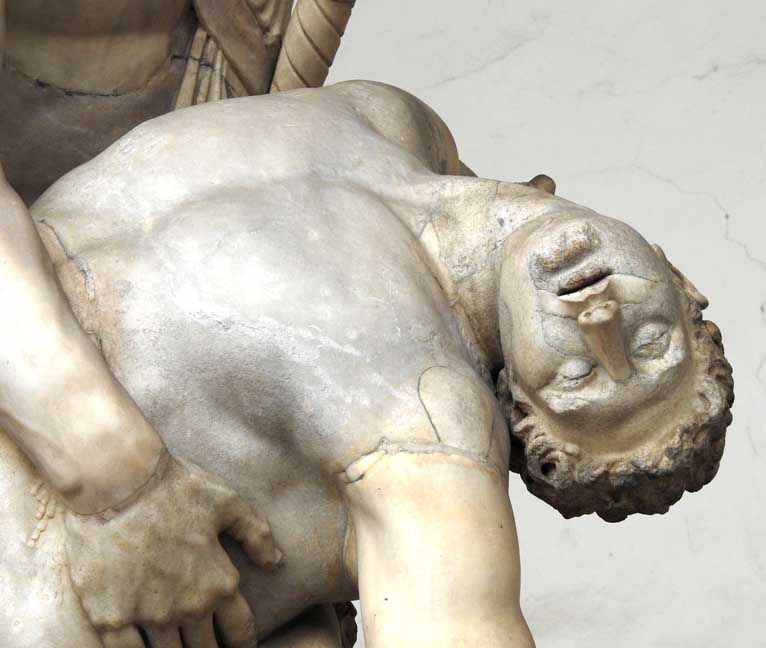 Menelaus and Patroclus |